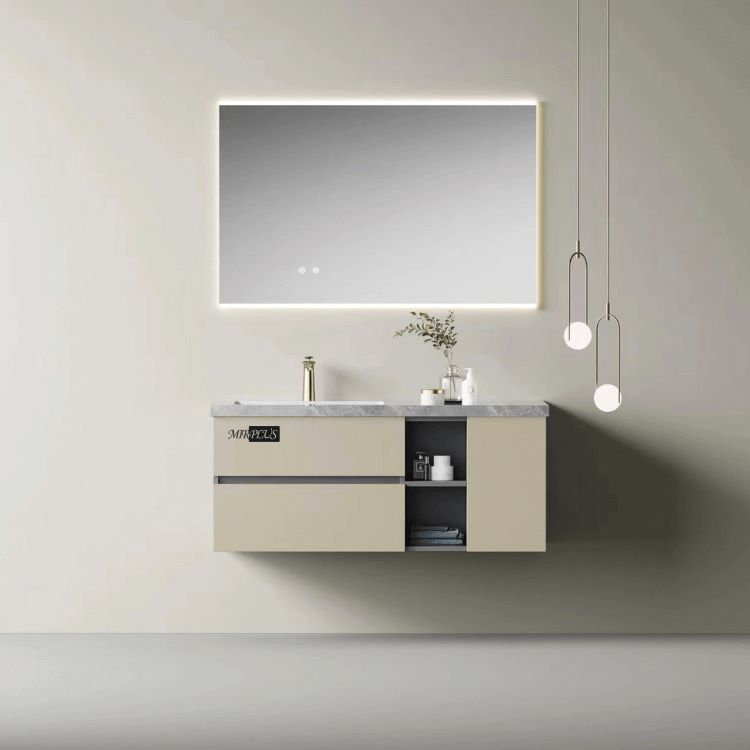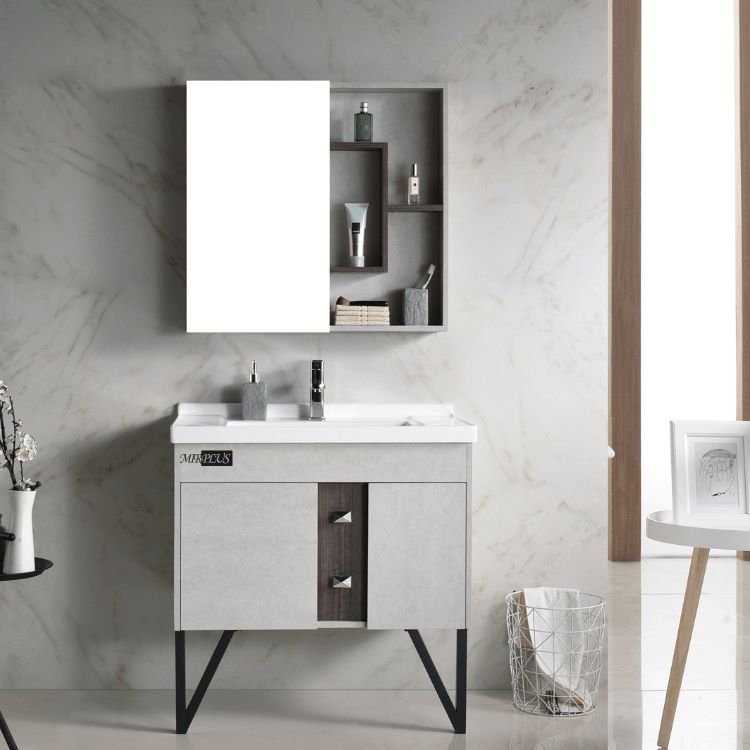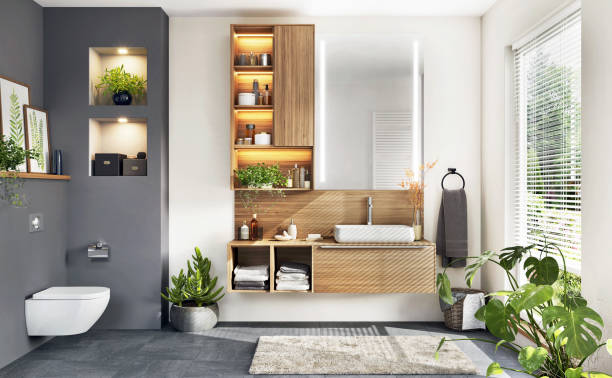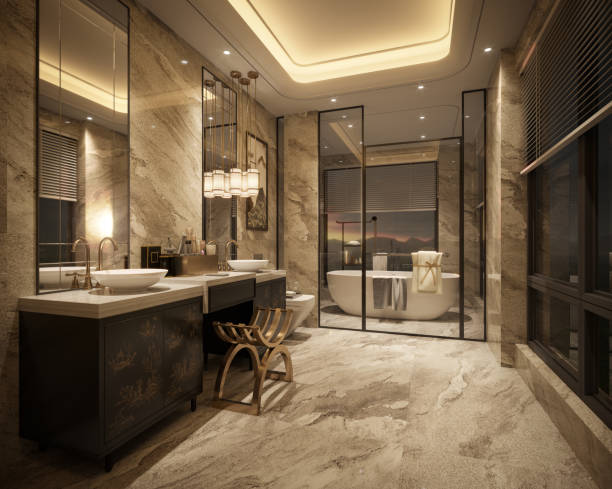Choosing a right style of bathroom vanity can make a huge change in you bathroom. It is not only about appearance, but relate to functions, organization about your space. You might think freestanding vanities are the only option for a functional bathroom, but that's not the case. Floating vanities offer a modern twist that can enhance your space while maintaining practicality. So, how do you choose between floating vanity vs freestanding? It all comes down to your space, aesthetic, and storage needs. In this guide, let’s explore the distinct features of floating vanity vs freestanding to help you make an informed decision that complements your vision.

A floating vanity is a sleek, wall-mounted option that adds a modern touch to your bathroom while creating the illusion of more space. True to its name, this type of bathroom cabinet is typically mounted on the wall using screw-lock fasteners.
This design creates the visual effect of the vanity appearing to float in the air, instantly lending the bathroom an open and airy atmosphere. You'll love how it simplifies cleaning, giving you easy access to the floor beneath.
Common materials for floating vanities include wood and medium-density fiberboard (MDF). For a luxurious ambiance, stone countertops may also be selected based on stylistic requirements. Vanities like this typically feature smooth finishes, natural wood grain, or matte surfaces, paired with clean linear designs to achieve a modern minimalist aesthetic.
Pros
While you explore bathroom design options, floating vanities stand out for their modern elegance and practical benefits.
Unlike a freestanding vanity, which can feel bulky, a floating design elevates your aesthetic, offering contemporary styling that fits various design themes.
Cons
Although floating vanities offer a modern aesthetic, they come with some drawbacks that potential buyers should consider.
Ultimately, weigh these cons carefully when considering floating vs freestanding vanity options.

A freestanding vanity is a classic choice that brings both charm and practicality to your bathroom. It is a vanity that sits directly on the floor, which either supported by solid wood legs or features a sturdy base.
Typically, these standing vanities are made by solid wood, medium-density fiberboard (MDF), or multi-layer solid wood, featuring surface finishes that encompass glossy lacquer, distressed effects, or aged finishes. Countertops often utilize materials like granite, marble, or quartz to add an elegant touch to the bathroom.
With its sturdy design and ample storage options, it can easily accommodate all your essentials, making it perfect for busy families.
Pros
As one of a traditional design for bathroom vanity, freestanding vanities offer a perfect blend of style and practicality, making them a popular choice for many homeowners.
Freestanding vanities also create a grounded look in larger bathrooms, enhancing visual balance. Ultimately, these vanities deliver on function and style, making them a smart addition to any bathroom renovation.
Cons
While many love the charm and functionality of freestanding vanities, they come with certain drawbacks that mightn't suit everyone's needs.
Finally, if you’re planning renovations, relocating a freestanding vanity is easier said than done, often requiring plumbing adjustments that complicate the process.
Now that we've explored their characteristics, each style comes with its own costs and advantages. Let's examine how they compare as you pursue your ideal bathroom space.
When choosing between floating vanity vs freestanding, you’re not just deciding on a look; you're considering space, storage, and ease of installation.

In the quest for the perfect bathroom aesthetic, the choice between floating vanity vs freestanding can considerably impact the overall vibe of your space.
Ultimately, you’ll need to evaluate your design goals; whether you lean towards modern minimalism or timeless elegance, the right vanity can transform your bathroom into a personal retreat.
Related Article: Bathroom Vanity Ideas in 2025: 11 Trends You Need to Know
No matter you choose which styles between floating vanity vs freestanding for your bathroom, think about how much storage you need first. A bathroom's functionality hinges considerably on its storage capabilities, and this is where the battle between floating and freestanding vanities intensifies.
Consider your current and future storage needs; freestanding designs excel in busy family bathrooms, while floating options work wonders in compact spaces.

Choosing between floating vanity vs freestanding vanity often boils down to installation preferences, as each style presents unique challenges and benefits.
Freestanding vanities offer a straightforward setup, needing only to be anchored to the floor, making them ideal for DIY enthusiasts. In contrast, floating vanities require secure wall mounting and possibly professional installation, which can elevate your bathroom's modern aesthetic.
| Feature | Floating Vanity | Freestanding Vanity |
| Installation Difficulty | Moderate to High | Low |
| Wall Support Required | Yes | No |
| Cleaning Ease | High | Moderate |
Consider your space and skills; whether you prefer sleek minimalism or classic charm, both styles can be tailored to elevate your bathroom experience.
Related article: Safely Replace Your Medicine Cabinet Mirror in 5 Steps
When it comes to costs, the prices varies for dealers, individual consumers, or wholesalers. Both floating vanity vs freestanding vanity can fit a range of budgets, but their price points often reflect their distinct features and installation requirements.
In terms of installation costs, freestanding sinks typically incur lower expenses since they do not require wall mounting. Conversely, floating vanity may needs higher costs due to the need for professional installation of support structures.
Of course, the choice of materials and surface finishes will also impact the final price.
Ultimately, understanding these costs helps you gain control over your renovation project, ensuring it aligns with your budget and design goals.
Considering the costs associated with each vanity type, it’s important to also prioritize safety and accessibility in your bathroom design between floating vanity vs freestanding.
Ultimately, think about who'll be using the bathroom now and in the future. Choosing a vanity that balances safety and style guarantees your space remains functional as life evolves.


Are floating sinks better than freestanding sinks or are freestanding sinks better than floating ones? In recent years, floating sinks have undoubtedly become the new favorite in most modern bathrooms, but does this mean they are superior? Not necessarily!
When choosing between floating vanity vs freestanding, each has its own distinct features, making it difficult to definitively declare one superior to the other.
Whether you lean towards the sleek elegance of a floating vanity or the solid presence of a freestanding one, your choice reflects your style and practical needs. When making a decision, consider your bathroom size, storage requirements, and overall design vision.
If spaciousness and modern aesthetics appeal to you, a floating vanity elevates your bathroom, creating an airy feel while simplifying cleaning.
On the other hand, if you value ample storage and a classic touch, a freestanding vanity offers substantial cabinetry and a grounded look.
Ultimately, the right vanity is one that aligns with your lifestyle, enhancing both functionality and beauty in your personal sanctuary. Control your space, and let it reflect who you are.
Just remember: There is no accounting for taste.
Choosing the right vanity can feel overwhelming, but it doesn’t have to be. You can simplify the process by focusing on key factors that align with your style and needs.
Consider these points:
When selecting bathroom cabinets, whether shopping online or seeking a partner, Mirplus are one of your ideal choices. If you're unsure whether to choose a freestanding or floating vanity, explore our product range—whatever your needs, we're sure to meet them.
In the end, choosing floating vanity vs freestanding vanity is like picking a partner for a dance; it’s all about finding the right rhythm for your space. If you crave modern elegance and a spacious feel, a floating vanity might just sweep you off your feet. But if you need storage and a classic touch, a freestanding option could be your perfect match. Trust your instincts, and let your bathroom reflect your unique style!
Q1. What is the difference between a floating vanity and a freestanding vanity?
A floating vanity is mounted to the wall, giving the illusion of more space. A freestanding vanity rests on the floor and offers traditional design and more storage.
Q2. Which one is better for small bathrooms?
A floating vanity is ideal for small spaces because it creates a sense of openness and makes the room feel less crowded.
Q3. Are floating vanities more expensive than freestanding ones?
Generally, floating vanities can be more expensive due to the installation requirements and the specialized mounting system. However, it depends on the material and design.
Q4. Do freestanding vanities offer more storage than floating ones?
Yes, freestanding vanities typically have more under-cabinet storage, as they rest directly on the floor and have enclosed bases.
Q5. Can a floating vanity support a double sink?
Yes, as long as the mounting system is properly installed and supported by sturdy wall studs, a floating vanity can hold a double sink setup for larger bathrooms.
Uncover a realm of opportunities.

Hi, I’m Emmy, a bathroom design enthusiast. My company Mirplus, backed by a team of professional designers, is dedicated to helping people select the perfect bathroom cabinets. I hope my articles can be helpful to you when choosing bathroom products in the future.
Copyright 2022 - All Mirplusbath